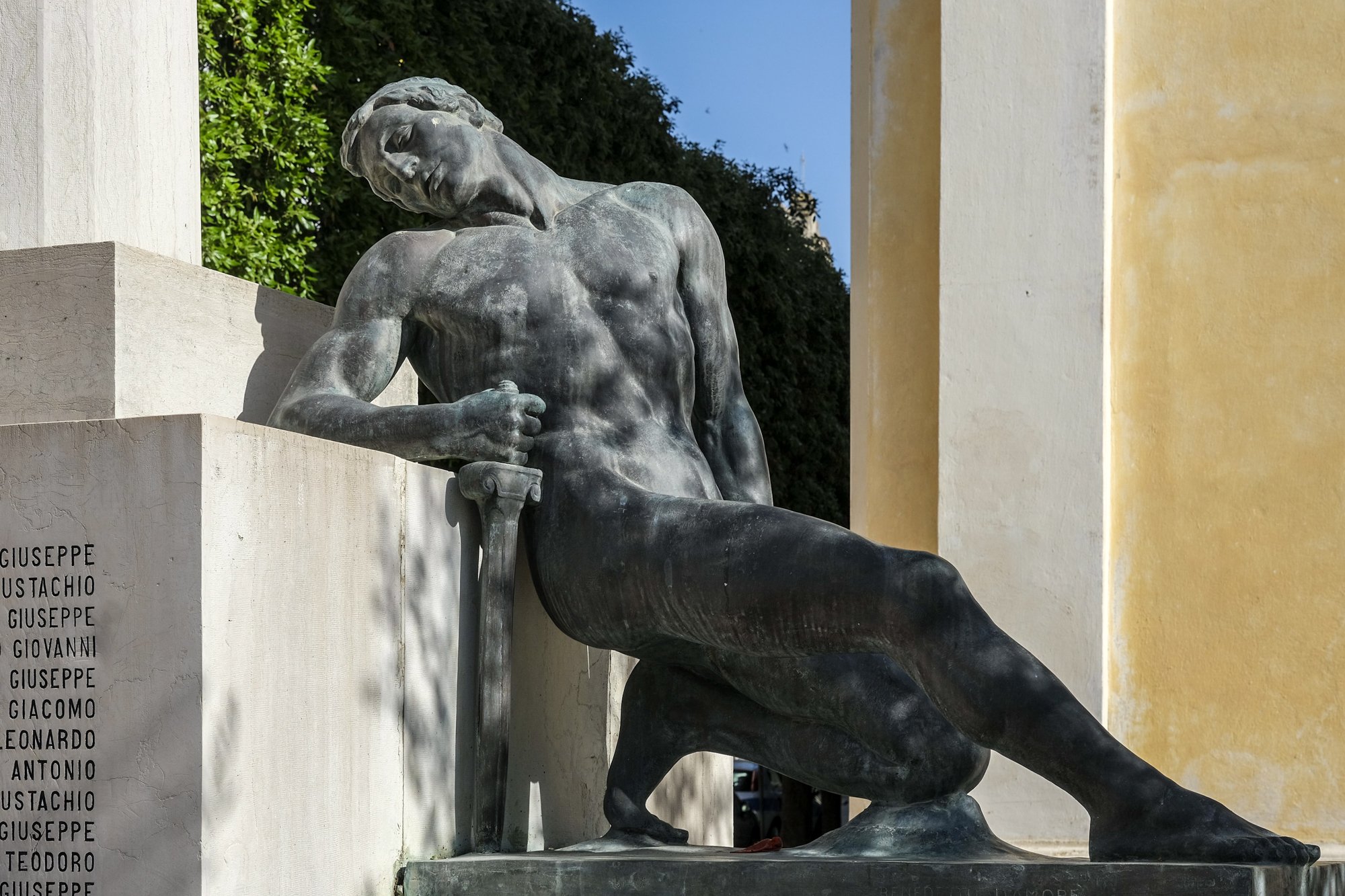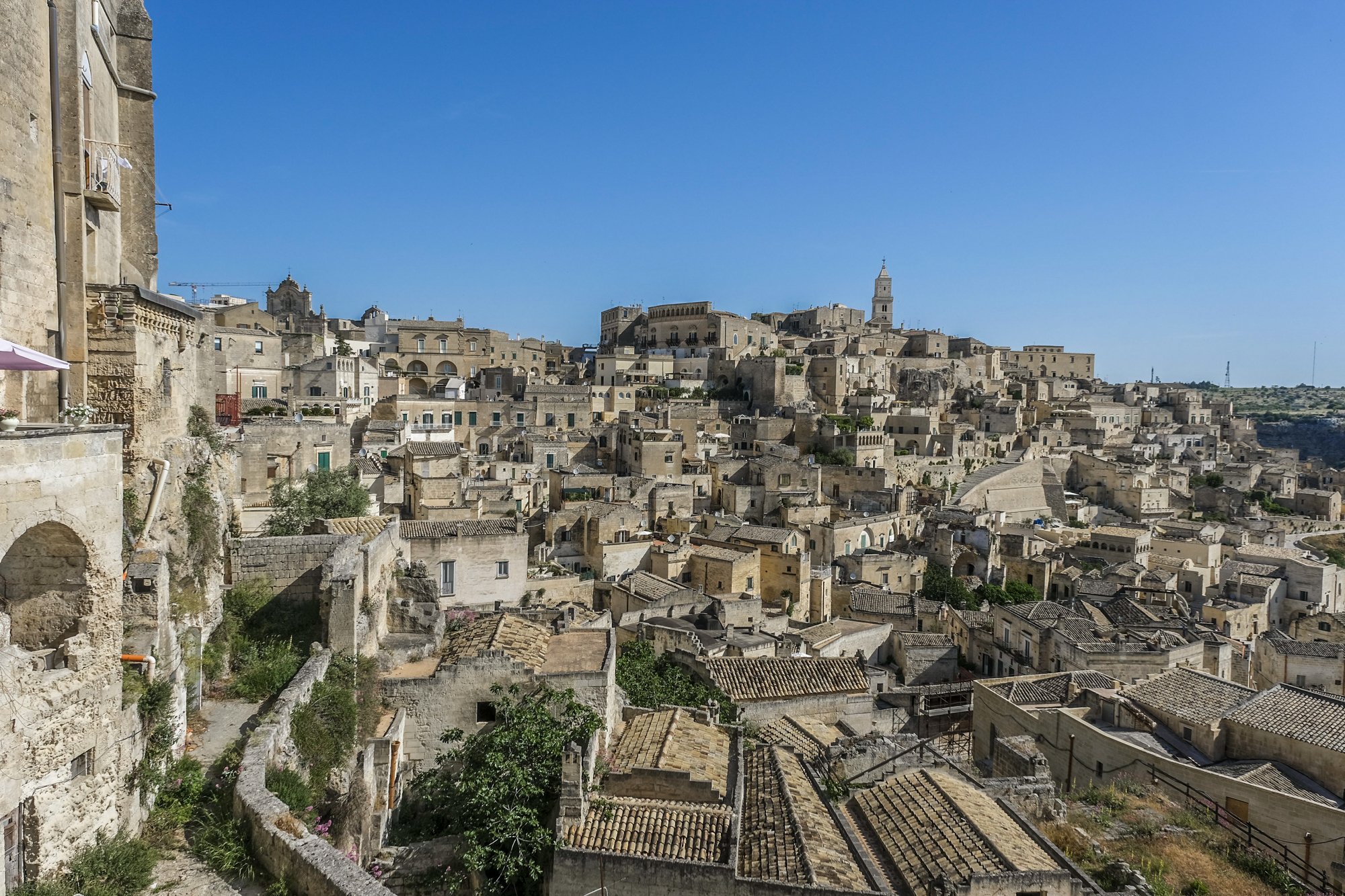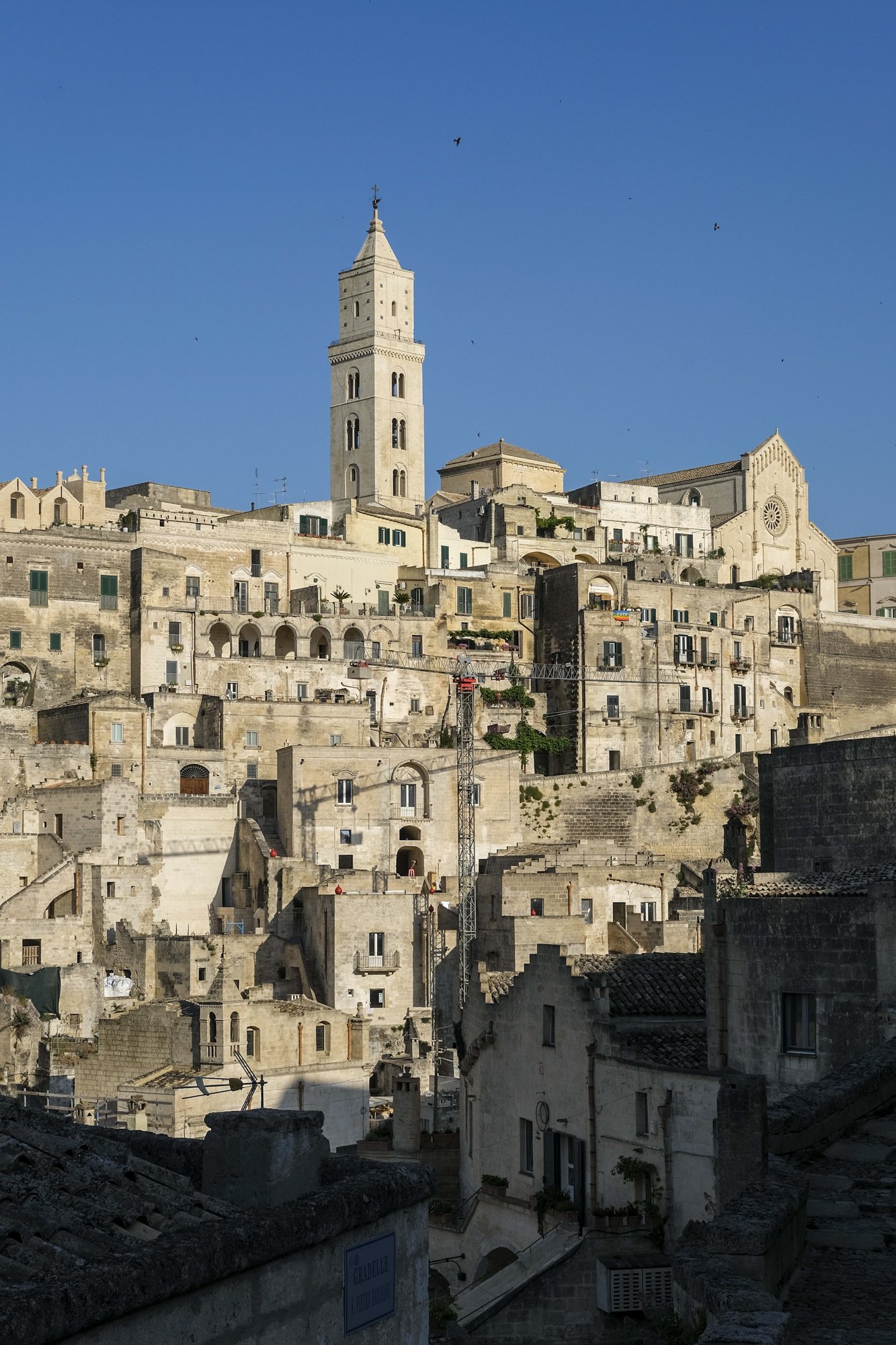Matera - The Cappadocia of Italy
Matera is a “must-visit” for our summer trip to Southern Italy and Lecce. This ancient settlement boasts one of the most unique urban landscapes in Europe and is one of the most beloved destinations in Basilicata. However, I must confess that I first learned about Matera from an episode of Alex Polizzi's Secret Italy. The British-Italian hotelier and presenter describe Matera as both haunting and beautiful. This was where she came for her honeymoon. Given her love and obsession for Italy, Matera has her ultimate stamp of approval. Although it is not a well-kept secret, Matera and Basilicata are still relatively unknown to American travelers.
Coming from Dolomiti Lucane, we had a very high expectation for Matera. As the signs for Matera appeared on the horizon, I was surprised to learn that Matera was a thriving metropolis. It is very different from the ancient, semi-abandoned city we saw on television. At first, this modern city of 60,000 residents seems to comprise mid-rise housing blocks, shopping malls, and an industrial zone on its outskirts. For a moment, I had a hard time believing we were actually in a historic city. Where was the Matera we see on postcards and travel blogs? Are there two separate Matera?
After driving around the city center for half an hour, I finally found a free parking spot near the town’s modern train station. Naturally, I followed the crowd into the town center to Piazza Vittorio Veneto. The bustling square is fronted by grand civic buildings such as the city hall, Church of Saint Dominic, and the Fascist-era Bank of Naples building. The bustling piazza was teeming with locals and visitors; it was a beautiful scene, but again… it was not the Matera I was looking for. Right on the piazza was a discrete staircase with a sign for “SASSI” next to it. Once emerging from the other end, I was transported to the Matera that we know. So now we know… the magic word is Sassi!
Sassi di Matera
So what was Sassi exactly? Sassi is an Italian word for “stone” and refers to the stone cave dwelling indigenous to this region. Matera took the cave construction to a whole other level. The local tufo stone was malleable enough to make the cave houses great shelter from the almost desert-like landscape. According to archaeologists, Sassi di Matera was first inhabited nine thousand years ago in the Paleolithic Age. The city is said to be the oldest continuously occupied city in Europe and the third oldest in the world. The cliffside of Gravina River offers ancient dwellers easy access to fresh water and shelter from the harsh wind. The closest comparison one could come up with might be Turkey’s Cappadocia.
While historians disagree about the exact evolution of Sassi, many families in Matera could trace back their family history for centuries to their ancestral cave dwelling. Since the Industrial Revolution, Matera suffered from enormous problems with emigration to larger industrial cities. The region around Matera was known to be the poorest region in all of Itlay. By the 1950s, the deteriorating conditions of Sassi di Matera were so acute that it was branded as a collective “Shame of Italy.” Almost none of the cave houses have electricity or working plumbing. The outbreak of malaria, cholera, and typhoid was rampant and posed a dangerous health risk for the wider region.
To avert an escalating health crisis, the city authorized the construction of modern apartments just off the ancient Sassi. In 1952, every one of the Sassi’s 15,000 residents was evacuated. Many cave houses and original furnishing sat empty for the next few decades. The ancient city was left to the attrition of nature and time for the next few decades. The new modern apartments they received were considered a major upgrade for the evacuated generation. After all, it is difficult to compete against electricity and running water.
To best understand the history of Sassi and the way of life back then, several of the original cave dwellings have been conserved and are now open to visitors. One that we visited is Storica Casa Grotta di Vico Solitario. For €5, we could peek into how families organized their households. Original mattresses and many farming tools are also on display. This small single-room “house” would house about a dozen family members and their livestock, such as mulls and horses. For heating, they used a mixture of manure and other organic matter. I could only imagine the stench inside the house. While visitors today could enjoy the rustic luxury of boutique Sassi hotels, visiting house museums like Casa Grotta put things into perspective and showed us how lucky we are.
It took another generation or two for the people of Matera to rediscover Sassi's historical and spiritual importance. The locals began to contemplate the future and preservation of their ancient heritage. Once again, families began to recognize the role of these dwellings in their lineage. In 1993, Matera was placed on the UNESCO World Heritage Sites list. With it, considerable money and expertise flowed across Italy and the European Union. Since then, Sassi di Matera experienced a remarkable revival. At first, it was just a few bars and eateries. But the trickle turned into a stream with the arrival of Hollywood.
In 2002, Mel Gibson selected Matera as the principal filming location for his blockbuster film The Passion of The Christ. The ancient appearance of Matera made it a convenient substitution for Roman Bethlehem and Jerusalem. Other films set in the same historical settings filmed in Matera include Ben-Hur (2016), Mary (2005), Mary Magdalen (2018), The Young Messiah (2016), and The Nativity Story (2006). Other non-biblical blockbuster films such as No Time to Die (2021) and Wonder Woman (2017) also found the Sassi a compelling film location.
Regarding tourism, what truly brought Matera into the spotlight was when Matera was designated as the 2019 European Capital Culture. In addition to €50 million worth of direct financial assistance from the European Union, this prestige designation brought forward a full year of cultural events and was designed to generate noticeable cultural and economic benefits to the host cities. It raised Matera’s international profile and spurred urban regeneration. Today’s visitors are ripe for the benefits of the economic prosperity brought by the recent development. It was remarkable that none of the boutique hotels and high-end restaurants around Matera are now more than twenty years old.
This “rebirth” of Matera is nothing short of remarkable. Today’s Matera is a traveler’s dream. Many luxury hotels, cafes, restaurants, and boutique shops are nestled within the rustic ruins. It is a far cry from this ancient city's previous rough and tumble. The whole area looked like a purpose-built stage set for travel influencers. The amount of care put into the city revival is astonishing. Every piece of masonry or stonework seems to be restored to top-notch conditions. Ironically, the Sassi di Matera appears even less deserted than your typical hill towns in Umbria or Tuscany. Matera gives hope to countless dying towns or villages all over Italy.
Sassi di Matera comprises two districts: the Sasso Caveoso to the south and Sasso Barisano to the north. Sasso Barisano is home to Matera’s main cathedral and many stately homes. Sasso Caveoso, on the other hand, is far less developed and perhaps more interesting for visitors. With many cave dwellings still not refurbished, it gave us a good glimpse of Matera from 30 years ago, before the arrival of tourism. But considering the popularity of Matera nowadays, it was only a matter of time before every single Sassi was converted for tourism. I have read that more than a quarter of the city’s housing stock is listed for rent on Airbnb, the highest rate in Italy.
Navigating around Sassi was quite tricky for any first-timer. The narrow twisting lanes often lead to dead ends. There is something new and unexpected at every corner. Sometimes, it was difficult for me to distinguish the boundary between the public walkway and the private staircases. According to historical accounts, this blurring of private and public spaces was a hallmark of life in Matera in centuries past. As expected, Google Maps and other similar GPS services don’t work well. For anyone who has timed reservations for tours or restaurants, it is probably wise to allow extra time. Our Airbnb host sent us a video of how to get to the apartment unit instead of a written direction.
Grand Churches of Matera
While getting lost within Sassi di Matera is the main attraction, many fascinating historical monuments are worth seeking. The grandest monument would be Matera Cathedral. Perched at the highest point of Sassi, the cathedral’s bell tower looks like it was pulled to the sky by god's hands. Constructed in the 13th century in the style of “Puglian Romanesque,” the cathedral appears austere and reminiscent of a solid fortress and is almost a carbon copy of the cathedrals at Bari. Though many are content with enjoying the beautiful vista from the piazza at the front, I think it is worthwhile to visit inside.
Not surprisingly, access to the cathedral interior requires a nominal admission outside of the time of religious service. The interior was an interesting blend of Romanesque and Baroque. The highlight would undoubtedly be the giant nativity scene at the left transept. It was the work of local sculptor Altobello Persio. The stone artwork of the nativity seems to evoke the urban morphology of Sassi. A big section of the floor in front of the nativity has been replaced with glass flooring. From here, we could inspect the ancient Church of Saint Eustace. Its beautiful fresco is in remarkable condition.
On ancient murals, Matera is probably in a league of its own. As a city of caves, quite a few rupestrian churches survived through the centuries. Among them, the most iconic and striking is the Church of Saint Mary of Idris. This church is built into a giant monolith called Monterrone. Together with the adjoining Crypt of San John, the interior is plastered with magnificent frescos dating from the 12th to the 17th century. Many of the murals carry characteristics of Byzantine mosaic, which signifies the close link between the Greek realm and this part of Italy. Unlike paintings on canvas, these murals adapt well to the undulating surfaces of the rock face. There is just something primal atmosphere of being inside a rupestrian church. I definitely would have thought these murals could have been from ancient times.
Unfortunately, no photography, even without a flash, was permitted inside because of the fragile state of these murals. Four other similar rupestrian churches have a shared ticketing system for anyone who might enjoy these murals. Since we were short on time, we visited a few “free” churches around Sassi. A surprising find was the Church of Sant’Agostino, a handsome monastery perched at the cliff's edge. Beautiful on the inside, the pièce de résistance was an ancient hypogeum with ancient murals dedicated to Saint William of Vercelli. After our trip to Malta last year, any mention of hypogeum piqued my interest.
But in all honestly, my personal favorite among all the churches is a little Baroque gem outside Sassi: Church of Purgatory (Chiesa del Purgatorio). This little church was constructed for the faithful to pray for any loved one stuck in purgatory. The concept of purgatory is very alien to a non-Christian like me. Nowadays, I feel like 99% of the deceased are “destined” for heaven. I have never heard the priest say: “Well, Tony is on his way to purgatory now.” What was particularly eye-catching for me was the church’s macabre decoration. The motif of skulls and skeletons is sprinkled across the facade. The most striking among them are rows and rows of skulls on the front doors. At the top of the doors are four skulls wearing a papal tiara, a bishop’s miter, a cardinal's hat, and a royal crown. It is a wonderful reminder that even the royals or the pope are not guaranteed to go to heaven.
If we could stretch the definition of a “church” a little broader, the most unusual church would be the Palombaro Lungo. Also nicknamed the “Cathedral of Water,” Palombaro Lungo is the largest underground cistern supplying water to the Sassi. The arid landscape of Basilicata necessitates water conversations by any means possible. The sister collects both spring and rainwater and has a maximum capacity of 1,310,000 gallons. Measured at fifty feet in height, the cistern was carved out of the native tuff rocks and plastered with a special waterproofing finish called cocciopesto. The soaring walls of the cistern echo ecclesiastical architecture.
Situated in the middle of Piazza Vittorio Veneto, the cistern was abandoned for a few decades after a new aqueduct was constructed in the 1920s. It was not until 1991 that a construction worker accidentally rediscovered the cistern. The excavated area of the cistern has been permanently left exposed to provide visitors an opportunity to get a glimpse of this underground realm. Today, it is perhaps the most intriguing historical site in Matera. For €3, visitors could join one guided or self-guided tour throughout the day. During our visit, there were only two slots for the English language guided tours: one at noon and another at 5 pm.
We arrived promptly at noon and were fortunate to get a spot on the guided tour. The fifteen-minute tour led us down to the bottom of the cistern. The cistern is beautifully illuminated with an interesting green, purple, and blue mix. It is easy to compare Palombaro Lungoto to Istanbul's Basilica Cistern. While the Matera’s cistern is smaller and more “primitive-looking,” I enjoy the organic quality of this place more. It elicited primal emotions and a sense of wonder within many of us.
Our guide pointed out a few interesting features that could be easily missed. One of the most interesting is a series of circular rust stains on the ceiling. These were left by the “lost” water buckets that got trapped in the cistern. But overall, I don’t think taking a guided tour is essential for a great visit. The tour lasted only fifteen minutes from start to finish, so visitors were constantly going through the space. Matera is making a killing out of this place.
Beyond The Sassi
After a whole day exploring Sassi, we were inevitably exhausted by the intense sun and endless staircase. The orderly street just outside Sassi felt like a much-needed respite. The “Baroque” section of Matera is surprisingly pretty and tidy. It resembles many northern Italy towns. Via del Corso and Via San Biagio form the city's spine and are ideal for the nightly passeggiata. Although Matera is now firmly on the tourism map, the city has yet to become the next Venice or Civita di Bagnoregio. The lack of easy transportation to other parts of Europe has kept out hordes of backpackers, whose interests are parties and cheap liquor. At Matera, you are more likely to see an upscale wine bar than a dance club. And that is just fine with me.
My initial disappointment with the modern urban sprawl was naive. The modern city prevents Matera from being completely enveloped by modern tourism. During our visit, I saw that the locals inhabited many renovated sassi. Laundries were still drying out of the windows, and the grandma was hanging out on the terrace. This peaceful coexistence between locals and tourists may be temporary, but there is no question that the restoration of the Sassi would not be possible without tourism. Government regulations and civic organizations such as Circolo la Scaletta have carefully managed the revitalization of Sassi.
As we walked around Sassi and marveled at the place’s beauty and history, we should all deeply appreciate all the work people have put into the revitalization throughout the generations. They often say Rome was not built in a day. Well, Matera wasn’t built in a millennium. As Matera transformed from the symbol of abject poverty to boutique glamour, we must reflect on how lucky we all are to enjoy this sanitized environment.
For anyone with enough time and physical agility, one of the best views of the Sassi was from the hills across Gravina Ravine. It is accessible through a grueling hike up and down across the Gravina River. In late May, wildflowers were still blooming, and I could hardly imagine just how quickly the hustle and bustle of Matera disappeared. This area is part of Parco della Murgia Materana, a natural reserve with archaeological significance. Half hidden on the side of the hill are countless natural and man-carved caves; many are rock churches with segments of ancient murals still intact.
However, I must admit I did not reach the top. According to Google Maps, the trek would take roughly an hour roundtrip. But thirty minutes in, I was only getting to the suspension bridge at the bottom of the ravine. Coincidentally, we were supposed to check out of our Airbnb apartment in an hour by then. I was a little upset with myself that I did not accomplish this hike. Have I become so unfit recently that many 60-year-old ladies were streaming past me? This reminds me of the time when 80 years old passed me during my pilgrimage to Adam Peak in Sri Lanka.
After my unsuccessful trek, we decided to take our car and take the long way to the top of the hill. After nearly forty minutes, I finally arrived at Belvedere Murgia Timone. From there, we had a panoramic view of Matera, with ancient Sassi in full view. Along the way, there are countless ancient and medieval caves, many signposted with historical information. It was a wonderful bookend to our visit to Matera and Basilicata.















































